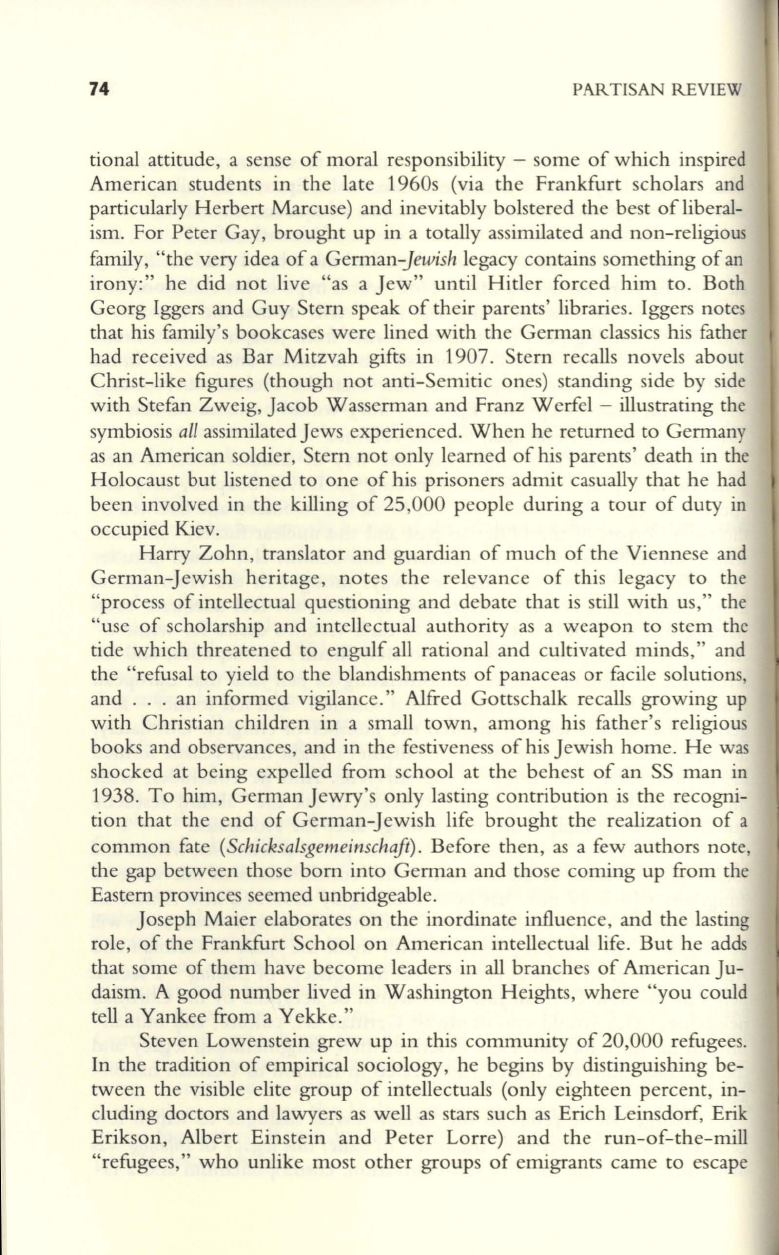
74
PARTISAN REVIEW
tional attitude, a sense of moral responsibility - some of which inspired
American students in the late 1960s (via the Frankfurt scholars and
particularly Herbert Marcuse) and inevitably bolstered the best of liberal–
ism. For Peter Gay, brought up in a totally assimilated and non-religious
family, "the very idea of a
German-Jewish
legacy contains something of an
irony:" he did not live "as a Jew" until Hitler forced him to . Both
Georg Iggers and Guy Stem speak of their parents' libraries. Iggers notes
that his family's bookcases were lined with the German classics his father
had received as Bar Mitzvah gifts in 1907. Stem recalls novels about
Christ-like figures (though not anti-Semitic ones) standing side by side
with Stefan Zweig, Jacob Wasserman and Franz Werfel - illustrating the
symbiosis
all
assimilated Jews experienced. When he returned to Germany
as an American soldier, Stem not only learned of his parents' death in the
Holocaust but listened to one of his prisoners admit casually that he had
been involved in the killing of 25,000 people during a tour of duty in
occupied Kiev.
Harry Zohn, translator and guardian of much of the Viennese and
German-Jewish heritage, notes the relevance of this legacy to the
"process of intellectual questioning and debate that is still with us," the
"usc of scholarship and intellectual authority as a weapon to stem the
tide which threatened to engulf all rational and cultivated minds," and
the "refusal to yield to the blandishments of panaceas or facile solutions,
and ... an informed vigilance." Alfred Gottschalk recalls growing up
with Christian children in a small town, among his father's religious
books and observances, and in the festiveness of his Jewish home. He was
shocked at being expelled from school at the behest of an SS man in
1938. To him, German Jewry's only lasting contribution is the recogni–
tion that the end of German-Jewish life brought the realization of a
common fate
(Schicksalsgemeinschaft).
Before then, as a few authors note,
the gap between those born into German and those coming up from the
Eastern provinces seemed unbridgeable.
Joseph Maier elaborates on the inordinate influence, and the lasting
role, of the Frankfurt School on American intellectual life. But he adds
that some of them have become leaders in
all
branches of American Ju–
daism. A good number lived in Washington Heights, where "you could
tell a Yankee from a Yekke."
Steven Lowenstein grew up in this community of 20,000 refugees.
In the tradition of empirical sociology, he begins by distinguishing be–
tween the visible elite group of intellectuals (only eighteen percent, in–
cluding doctors and lawyers as well as stars such as Erich Leinsdorf, Erik
Erikson, Albert Einstein and Peter Lorre) and the run-of-the-mill
"refugees," who unlike most other groups of emigrants came to escape


